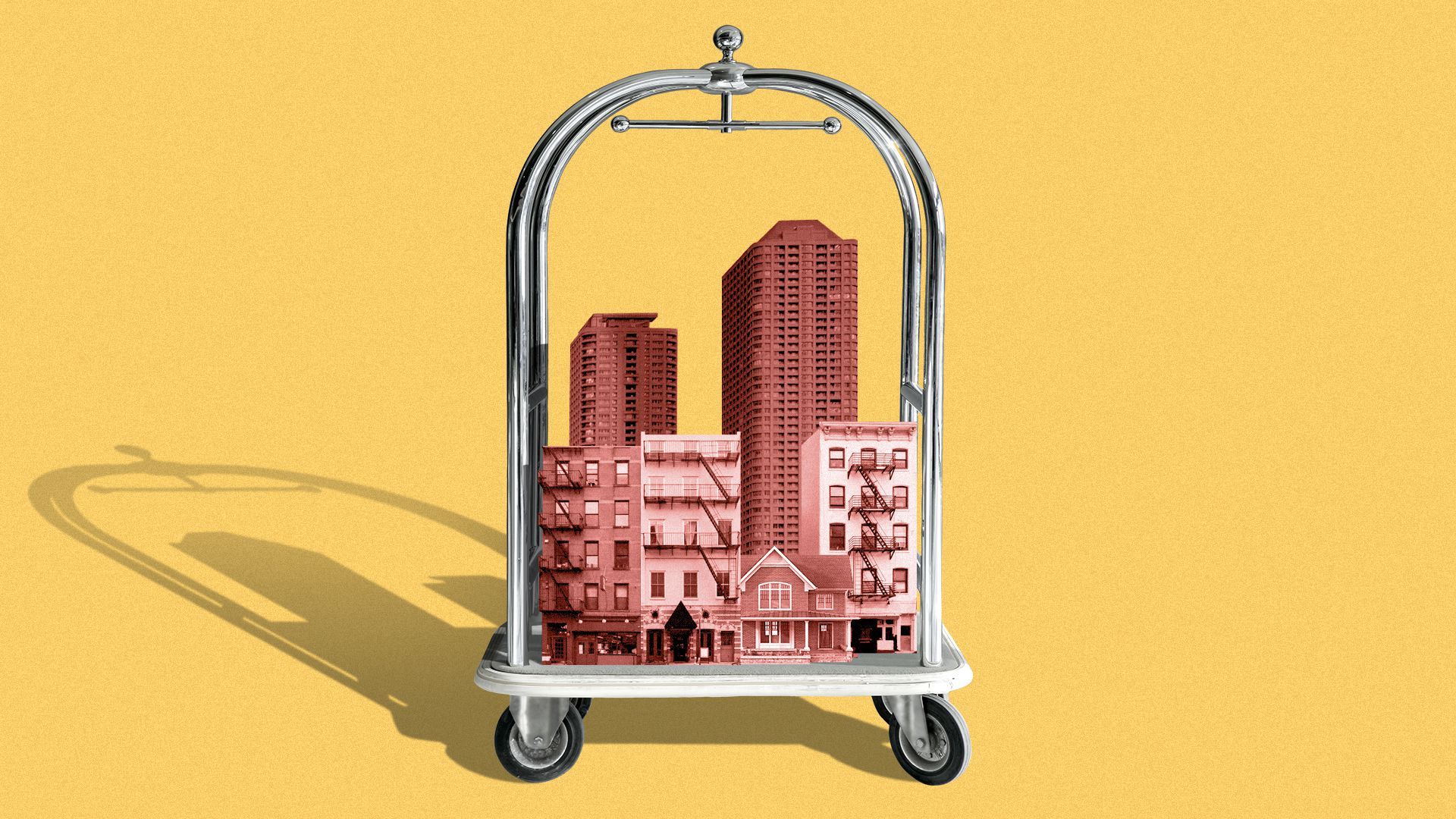| | | | | | | | | | | Axios Markets | | By Matt Phillips and Emily Peck · Jul 29, 2022 | | 😅 It's me, Emily, and I'm ready for the weekend. I mean, what a year this week has been. So much economic data to process. Much of it is pretty dour. (We break it down this morning on "Axios Today.") - And yet, after reading what Matt has to say below, I'm thinking it might be safe to check my 401(k) balance again. Are any of you checking yours? Reply and let me know.
Today's newsletter, edited by Javier E. David, is 1,041 words, 4 minutes. | | | | | | 1 big thing: Investors love recession! |  | | | Illustration: Shoshana Gordon/Axios | | | | The stock market keeps chugging higher despite growing evidence that the economy is in deepening trouble, Matt writes. Driving the news: The S&P 500 posted yet another gain yesterday, even after new data showed the economy shrank for a second straight quarter. - The index is up more than 7% so far in July, enjoying its best month since November 2020, when positive news about the effectiveness of COVID-19 vaccines first emerged.
The intrigue: Of course, stocks rallying on the arrival of vaccines seems to make intuitive sense. (It portended a recovery from an ugly economic and public health crisis.) - Is it logical, then, for stocks to rally on the prospect of recession?
The answer: Yes! Around here, we often say "the stock market is not the economy (TSMINTE™ for short)." - It's our shorthand to remind you that despite decades of press coverage that conflates economic conditions and stock market performance, the market actually has done quite well during downturns. This is especially true when the Federal Reserve cuts interest rates.
- Just look at the anni horribili of 2020 and 2021. Hundreds of thousands of dead. Millions of jobs lost. The sharpest downturn on record. Well, during those dark years the S&P 500 rose 50% as Fed easing pumped trillions into markets.
State of play: Flash forward to this year. It was the Fed's relatively rapid move against surging inflation — hiking rates and pulling back on money printing — that crushed the stock market, sending the S&P 500 down nearly 24% as recently as mid-June. - Since then the stock market is up more than 11%. What's changed?
 Data: FactSet; Chart: Axios Markets The bottom line: Interest rates tell the story. Starting in mid-June, the yield on the 10-year Treasury note — the most widely followed bond gauge, has plunged from about 3.50% to about 2.70%. (As we've explained before, falling interest rates almost automatically push share prices higher by raising market valuations.) Rates go down when expectations about growth and inflation fall. So, in a way, it's actually the fears of the slowdown that are helping to drive share prices up. - Weird but true. And totally consistent with TSMINTE™.
|     | | | | | | 2. 🤘🏼Metal prices falling hard |  Data: FactSet; Chart: Axios Visuals Iron ore prices are tumbling as China's housing woes worsen, Matt writes. Driving the news: Prices for the key ingredient in steel have tumbled 50% over the last year. Why it matters: The price tumble shows how issues in the world's second-largest economy are rippling outward to the rest of the globe. - Countries like Brazil and Australia are major exporters of iron ore to China.
What they're saying: "Iron ore, more than any other global commodity, is tied to early cycle property activity in China. This sector segment generates close to a third of China's steel and iron ore demand, which in turn represents close to a quarter of global seaborne demand," Goldman Sachs analysts wrote in a recent note. Context: The country's housing market has been in distress for most of the year since giant Chinese home builder Evergrande nearly collapsed under the weight of its outsized debts. - The crisis chilled investment in housing, prompting a widespread downturn in construction, and generating a persistent headwind for the economy.
What to watch: The Communist Party congress, where President Xi Jinping is expected to be elevated to a third term. And possible stimulus measures aimed at boosting the Chinese economy. |     | | | | | | 3. America's new favorite pastime |  Data: LottoReport.com; Chart: Erin Davis/Axios Visuals More than $400 million is likely to be wagered on lottery tickets by 11pm tonight, bringing a U.S. lottery jackpot to more than $1 billion for only the fourth time ever, Axios' Felix Salmon writes. Why it matters: Millions of Americans have bought a ticket, dreaming of what they would do with a post-tax lump sum estimated at more than $600 million. Catch up quick: The lottery is played in 45 states, plus the District of Columbia and the U.S. Virgin Islands. Out of each $2 ticket, roughly 35 cents goes to non-jackpot prizes, about 75 cents goes to fund the jackpot, and the remaining 90 cents goes to the government. - The chance of winning the jackpot — about 1 in 300 million — is statistically indistinguishable from zero. You're much more likely to be eaten by a shark, struck by lightning, or even killed by an asteroid.
- Don't bother buying two or more tickets: Ten times zero is still zero.
Be smart: You're not going to win the lottery. But that's not the point. The point is that with your $2 you're purchasing the dream of being able to win the lottery. The bottom line: Don't feel guilty about spending $2 on playing the lottery this week. And if you want to keep the dream alive, simply don't check your numbers! Go deeper. |     | | | | | | A message from Axios | | Don't dig for your deals | | |  | | | | Discover how Axios Pro simplifies your daily research with exclusive reporting and analysis in Axios' concise Smart Brevity format. - We'll get you smarter, faster on the deals, trends and companies transforming your industry.
Use code PRO200 at checkout to get $200 off your subscription. | | | | | | 4. Catch up quick | | 🛢 Chevron posts record $11.6 billion quarterly profit. (WSJ) 🙅🏼♀️ Instagram rolls back changes after Kardashian slam. (CNBC) 📱Apple earnings and revenue top expectations. (Axios) ⬆️ Amazon revenue and growth flatten, but stock jumps. (Axios) |     | | |  | | | | If you like this newsletter, your friends may, too! Refer your friends and get free Axios swag when they sign up. | | | | | | | | 5. The rent is (still) too damn high |  | | | Illustration: Lindsey Bailey/Axios | | | | Even as economic storm clouds gather and the housing market craters, the rent is still too damn high across several metropolitan regions, Javier writes. Why it matters: In theory, the pandemic-era exodus from both coasts to the Sunbelt region should have cooled demand for rentals and tamed prices. - In actuality, the Big Apple is offering virtually no relief to renters at all income levels. And believe it or not, there are some plausible explanations why.
What they're saying: Lior Rachmany, CEO and founder of Dumbo Moving in NYC, has executed over 100,000 moves since the onset of COVID-19. About 65% of those were out of the Big Apple, which has fallen to around 50% currently. So with all that migration, why is apartment inventory still so scarce, and rents so high? Rachmany has an answer, and it lies in New York's reputation for being an aspirational city for people from all walks of life. - "...A lot of young professionals after graduating school are choosing NYC over other cities, trying to pursue their dreams here," he tells Axios.
The bottom line: "Most New Yorkers can't afford [these rents], and what's available is not available anymore. In terms of renters, whoever is looking to rent is not a good place to be right now, the market is very high and [there is] not a lot of inventory," Rachmany added. Read more. |     | | | | | | A message from Axios | | Don't dig for your deals | | |  | | | | Discover how Axios Pro simplifies your daily research with exclusive reporting and analysis in Axios' concise Smart Brevity format. - We'll get you smarter, faster on the deals, trends and companies transforming your industry.
Use code PRO200 at checkout to get $200 off your subscription. | | | | 🍴1 thing Emily is intrigued by: utensils you can eat. Eco-friendly companies are now making cups, spoons and straws that you can eat after using, our colleague Jennifer A. Kingson reports. Think strawberry-flavored straws but also coffee-flavored coffee cups?! On the one hand, yuck. If the food sits too long in one particular product, "the smell may slightly penetrate the meal..." On the other hand, this could be a tasty way to not create a lot of plastic waste. What do you all think? Here's Jen's story. Reply and let me know. |  | | Why stop here? Let's go Pro. | | | | | | Axios thanks our partners for supporting our newsletters. If you're interested in advertising, learn more here.
Sponsorship has no influence on editorial content. Axios, 3100 Clarendon Blvd, Arlington VA 22201 | | | You received this email because you signed up for newsletters from Axios.
Change your preferences or unsubscribe here. | | | Was this email forwarded to you?
Sign up now to get Axios in your inbox. | | | | Follow Axios on social media:    | | | | | |












No comments:
Post a Comment